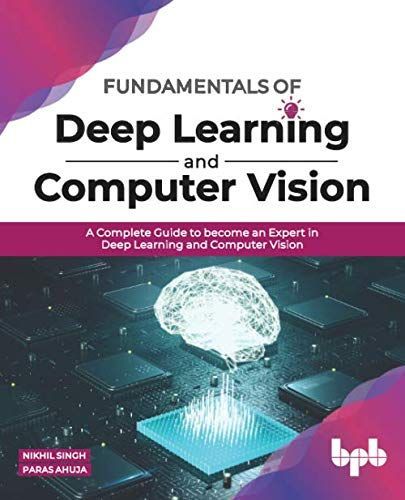
Fundamentals of Deep Learning and Computer Vision A Complete Guide to become an Expert in Deep Learning and Computer Vision
Master Computer Vision concepts using Deep Learning with easy-to-follow steps DESCRIPTION This book starts with setting up a Python virtual environment with the deep learning framework TensorFlow and then introduces the fundamental concepts of TensorFlow. Before moving on to Computer Vision, you will learn about neural networks and related aspects such as loss functions, gradient descent optimization, activation functions and how backpropagation works for training multi-layer perceptrons. To understand how the Convolutional Neural Network (CNN) is used for computer vision problems, you need to learn about the basic convolution operation. You will learn how CNN is different from a multi-layer perceptron along with a thorough discussion on the different building blocks of the CNN architecture such as kernel size, stride, padding, and pooling and finally learn how to build a small CNN model. Next, you will learn about different popular CNN architectures such as AlexNet, VGGNet, Inception, and ResNets along with different object detection algorithms such as RCNN, SSD, and YOLO. The book concludes with a chapter on sequential models where you will learn about RNN, GRU, and LSTMs and their architectures and understand their applications in machine translation, image/video captioning and video classification. KEY FEATURES Setting up the Python and TensorFlow environment Learn core Tensorflow concepts with the latest TF version 2.0 Learn Deep Learning for computer vision applications Understand different computer vision concepts and use-cases Understand different state-of-the-art CNN architectures Build deep neural networks with transfer Learning using features from pre-trained CNN models Apply computer vision concepts with easy-to-follow code in Jupyter Notebook WHAT WILL YOU LEARN This book will help the readers to understand and apply the latest Deep Learning technologies to different interesting computer vision applications without any prior domain knowledge of image processing. Thus, helping the users to acquire new skills specific to Computer Vision and Deep Learning and build solutions to real-life problems such as Image Classification and Object Detection. This book will serve as a basic guide for all the beginners to master Deep Learning and Computer Vision with lucid and intuitive explanations using basic mathematical concepts. It also explores these concepts with popular the deep learning framework TensorFlow. WHO THIS BOOK IS FOR This book is for all the Data Science enthusiasts and practitioners who intend to learn and master Computer Vision concepts and their applications using Deep Learning. This book assumes a basic Python understanding with hands-on experience. A basic senior secondary level understanding of Mathematics will help the reader to make the best out of this book. Table of Contents 1. Introduction to TensorFlow 2. Introduction to Neural Networks 3. Convolutional Neural Network 4. CNN Architectures 5. Sequential Models